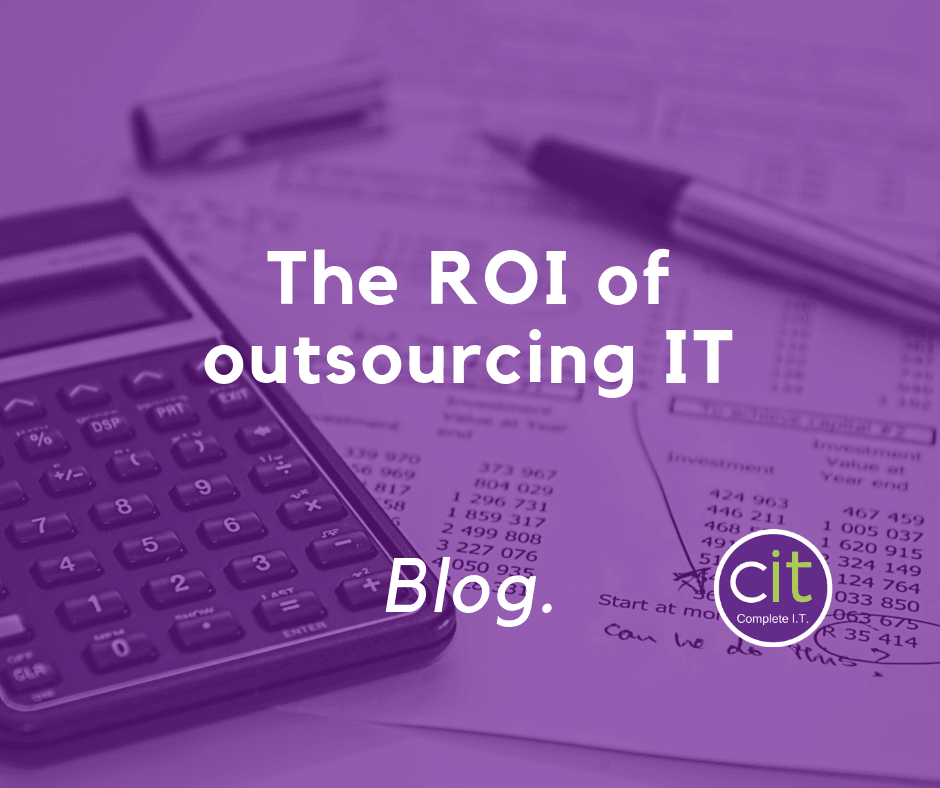
Outsourcing your IT brings a whole host of benefits to your organisation. Whether that be reduced cost, greater expertise, or more time to focus on your businesses core strategic initiatives, your organisation can reap the rewards of having an outsourced IT team dedicated to taking care of your systems. When it comes to outsourcing, the Return on Investment (ROI) is a metric you will probably be watching very closely as you assess the effectiveness of your decision.
With IT at the centre of pretty much every department within your organisation, from admin to accounting, it would be nearly impossible to run a successful organisation without it. This means that calculating the ROI of outsourcing IT can often be tricky as so many functions and operations depend on it. When it comes to calculating the ROI of outsourcing your IT department it is important to examine the cost, both in terms of cash and time of having an in-house IT manager/department, in order to fully appreciate the savings that come as a result of outsourcing. We have put together a series of questions that you should be asking yourself when calculating the ROI of outsourcing your IT.
Are we running more efficiently?
A great way to score your organisations ROI on outsourcing is to assess how it has affected or will affect your organisations efficiency. When leaving your IT systems to an inhouse team, or perhaps taking the responsibility on yourself, your expenses are more than likely going to be much higher than an outsourced service. This comes down to a range of things such as the cost of maintaining highly trained IT professionals, and the possibility of downtime when things go wrong. Having an IT provider means your organisation is in a much stronger position to combat business downtime and so having an idea of how much said downtime costs your business per year is an important metric to have in mind.
To calculate the cost of downtime to your organisation, think about your total revenue and divide it by 2080 – this number is based on the number of hours your organisation is in operation over the course of the year based on a typical 8 hour day. The resulting number is the average amount of money your organisation makes in an hour. Now think about the amount of downtime your organisation experiences each year – recent research carried out by the Daisy Group suggests that SMEs suffer an average of 45 minutes of downtime per week, roughly 9 minutes a day or 39 hours a year. You will then need to multiply this number by the average amount of money your organisation makes in an hour to calculate the cost of downtime. To bring the cost of downtime to life, lets think about an organisation that has an annual total revenue of £5 million. In an hour they make £2,403 and experience an average of 39 hours of downtime per annum. For an organisation of this size, the cost of downtime is a huge £93, 717 a year. When outsourcing your IT to a support provider like Complete I.T., we use our monitoring systems to ensure we are aware of any issues that may cause your organisation to suffer downtime and put the appropriate measures in place to prevent them from leading to such an event. Think of those savings!
Outsourced IT providers like Complete I.T. also promote the better use of technology and help to keep your organisation up to date with industry standards. This in turn will help to greatly improve the productivity of your organisation through the use of systems such as Office 365 – a package built for the purpose of increasing productivity and collaboration.
Do you have more time to spend on business processes?
A huge benefit of outsourcing your IT is the additional time you can spend on core business processes. When looking after IT yourself with no dedicated in house team, different employees may find themselves attempting to fix technical issues which obviously takes them away from their main responsibilities, costing your organisation a lot of time and output. On top of this, it is very rare for organisations to rely on just one system or piece of software. With multiple systems in place, it takes a lot of time to liase with different IT vendors, again taking your employees away from their main responsibilities that ultimately make your business money.
Think about this; if each week 5 employees can’t login to their computers and spend the next 20 minutes trying to figure out why, that equates to 100 minutes or nearly 2 hours per week spent on log in issues alone. When you add in things like troubles connecting to printers, accessing emails, locating files etc you can be looking at anything between 2 and 5 hours per week of employee manpower. Should your systems be outsourced, employees can get on with other tasks while waiting for their support provider to resolve the issue at hand.
Have you reduced your labour costs?
Outsourcing any part of your organisation should help to reduce your labour costs as well as boosting your organisations productivity levels. For an SME, hiring a full time IT manager can use up a lot of resources they simply may not have to dedicate to such an employee.
A main ROI of outsourcing your IT support is that it can massively reduce your labour costs. IT staff are present to generally fulfil three main responsibilities; 1) Monitor servers; 2) maintain databases and 3) assist with technical problems. But what happens when there is nothing for them to attend to? You can be paying a day’s wages merely for the presence of an IT person. When outsourcing your IT support, you can benefit from 24-hour support and highly trained professionals at your disposal when you need them, without the need of having an IT manager on the payroll. With a fixed monthly fee you can budget more effectively and prevent the need for nasty unexpected costs when things go wrong.
Is our data more secure?
As an SME in the world of GDPR, you should care about protecting your data – an important feature of outsourced IT support is securing your network against potential cyber criminals, and as such security should be high up on the list of ROI’s when assessing the effectiveness of outsourced IT support. You should benefit from scheduled data backups, in-house training and cyber security best practices when outsourcing IT support, and as such will also benefit from further cost savings when not needing to pay for these provisions yourselves.
Is your current outsourcing company the best choice?
IT is arguably the most essential process that SMEs consider outsourcing, and so ROI should be key in deciding whether to continue to outsource, or the decision to make the first step all together.
With all of the above questions in mind, if you feel like you aren’t getting a great return on investment don’t give up on outsourcing just yet. It may be that you haven’t selected the best outsourcing company – they may not be proactively monitoring your systems, they may not be promoting cybersecurity best practices, and they may not be backing up your data. If any of these ring bells, it might be time to look at what other providers can offer. See our IT support services.



